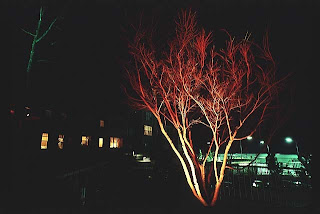~Vincent
Van Gogh
Imagine spending laborious hours designing,
landscaping, and planting in a garden, only to not have any time to actually
enjoy the fruits of that labor. Night gardens, also called moon gardens or
evening gardens, are one way that busy individuals are able to take pleasure in
their gardens “after hours.”
These intriguing gardens can be traced back to
medieval Japan, where gardens were created using white sand, white rocks,
water, and white chrysanthemums to attract the moonlight. In 17th
century India, plants like lilies, jasmine, and narcissus were used with the
express purpose of reflecting the light after dark.
A night garden’s design is unique in that it
relies on light to illuminate and transform the landscape and plants. White,
yellow, and silver plants like silver sage, White Eyed Susie, lilies, White
Queen, four o’-clocks, and Cart White are common inclusions as they reflect
both moonlight and artificial lighting. Night gardens delight the senses, as
they focus on stimulating sight and smell. A distinguishing characteristic of a
night garden is the sweet fragrance that perfumes the air, more so than other
gardens for very good reason. These gardens are rife with night bloomers that
possess a strong scent, such as evening primrose and honeysuckle, to attract
night pollinators that rely on their sense of smell.
The Archives of American Gardens contains wonderful
examples of gardens that can be enjoyed in the evening hours. Brush Hill
Gardens in Connecticut is comprised of purple, yellow, and green foliage that
will be reflective at night.
Post Court in Gwinnett County, Georgia uses
artificial lighting to brilliantly set aglow a Japanese Maple at night.
 |
|
PostCourt, 1988. Hooks, John D., photographer
|
The Maida Babson Adams Collection contains an image of Ellistan, which shows a daytime view of a terrace garden designed as a night garden.
 |
| Ellistan, ca. 1992-1994. Molly Adams, photographer |
Night gardens may require more imagination and
planning to coordinate with their daytime version, but they are truly worth the effort since they ensure a garden can be
appreciated continuously.
For more information about night gardens, please
visit:
Bella Wenum, 2013 Summer Intern








No comments:
Post a Comment